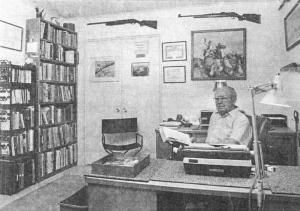
Edward Beverly Mann used his Kansas upbringing to carve out a notable career as a Western novelist and publishing editor. Beverly, as he was known in his early years, was born at Hollis, Cloud County, Kansas on January 31, 1902. He was the son of Grant and Mattie (Hill) Mann. His first cousin was Charles Elliott Mann, also a member of the Osborne County Hall of Fame.
Beverly’s father, Reverend Grant Mann, served as a Methodist minister and as such the family moved frequently. Beverly spent his boyhood years living in Downs, Osborne County, Kansas, where his parents eventually passed away and now lie buried. He attended both grade and high school there through his junior year, when the family moved to Oberlin, Decatur County, Kansas. Beverly graduated from Decatur County High School in 1920.
* * * * *
Autobiography of Edward Beverly Mann
(for Field & Stream Magazine)
Autobiography is treacherous ground for a writer; if he writes well of himself he is a braggart, and if he writes otherwise he is a fool. But when a writer’s Editor says, “Give me an autobiography,” one writes it – even when the Editor adds, “Omit the unspeakable and the obscene!” What is meat without salt?
Anyway, I was born in Kansas in 1902; so if you distrust anyone over 30, stop here. I’m glad I didn’t stop there, since most of the best things in my life happened after 30 – as some of the current generation will find, too, as they approach maturity.
My father was a Methodist minister, at the beck of a church system which keeps site preachers on the move; so my early schooling was in a series of Kansas towns, ending with graduation from Decatur County High School (Oberlin, Kansas) where I majored in football, baseball, and girls – all much more demanding than the books, which were easy.
Supremely confident of my wisdom at that ripe age of 18 years I decided that four years in college could be a waste of time. Working in spare time during the High School years, I had become a qualified linotype operator and feeder of a variety of printing presses, a capable wielder of pitchfork or scoop in the wheat harvests, and a fair handler of horses and mules under harness or saddle – so why not get rich quickly and get on with it?
So I came to Florida, where there were even fewer printshops than in Kansas and no farming of any kind with which I was familiar, and became a haberdashery clerk.
I have nothing against haberdashery, or clerking. But I must say that in 1920, it was no quick road to riches. So, in 1923, I went to college. I had played a bit of semi-pro baseball in those intervening years, which effectively blocked any aspiration to become a college athlete; at 5’ 8” and 160 pounds and meager talent, it was a faint hope anyway, but the books were still easy, and were increasingly interesting as they began to fit my real aspiration, to be a writer.
Four years later, late in 1927 I went to New York City and landed in an advertising agency. The pay fell considerably short of affluence, but there was Horn & Hardhart, where fat sandwiches cost only a dime and a cup of “the best coffee in town” cost only a nickel, and a furnished room was an adequate attic for a writer. Within a year I was grinding out western stories. My first sale was for $150. I spent most of it for an overcoat. That was a damned cold winter!
After that first story sold to Ranch Romances in 1927, I became one of the ‘pulp paper-pros’. Although the prices they paid seem pitiful now, [seldom more than three cents a word, and then only to us regulars], they provided markets for the script that failed to make the ‘slicks’ and a buck was a buck in those days.
Damned little research was needed to write the formula Western demanded by those editors, few if any of whom had ever ventured west of the Hudson. If any close proximity to fact had been required, few of the writers who supplied those markets could have provided either. I had an edge because I grew up where much of the old Western action had been, while old stories were still told by people who had lived them, or whose parents had. I at least knew which end of a horse you mounted from, the difference between a steer, a bull, and a heifer, how cattle were worked, how the people thought and talked, and a little something about guns and gunmen.
One oddity about the old Western stories: they were the favorite reading of cowboys. Dog-eared old Western pulps were stacked in every bunkhouse, traded from ranch to ranch. They were, and still are, printed in German and Spanish and other various languages.
The rest of the story is in “Who’s Who in America.” “Who’s Who” is a difficult achievement for many successful men, but it is an easy one for a writer; all he needs to do is to get a few books published. So my mention of it is not a boast. I never wrote The Great American Novel, or ever tried to. I wrote for pay; and while it never made me rich, it was a good living, one that permitted me to live wherever I chose, do pretty much as I pleased. Given those ingredients, plus good health and a good marriage – what more can a man ask of life? I’ve had them all.
In the 1940s I worked for the National Rifle Association, first as American Editor, then as Managing Editor of “The American Rifleman.” Later, now living in Albuquerque, New Mexico I was Director for some nine years of the University of New Mexico book publishing program. I moved to Chicagoland as Editor of “Guns Magazine” and of the firearms-industry trade magazine “Shooting Industry.” All of these employments involved work closely akin to writing, and all were rewarding – the more so because, if one wearied of them, there was always the easy “out:” Back to the real job – writing.
I’m still writing – for pay, yes; but mostly because I believe strongly in the shooting sports, in the right to keep and bear arms in the need to defend those sturdy American traditions.
E. B. Mann, 1971
* * * * *
Mann attended the University of Florida from 1923 through 1927, but left just before graduation under a cloud (he was later exonerated completely from theft charges and awarded his degree). In 1927 he moved to New York City and worked for the Willard Price & Company advertising agency. During this period he met and married Helen Frazier Cubberly on October 18, 1928. After another year at the agency he became a freelance writer of Western fiction and articles. Many featured a popular reoccurring character, Jim Whistler, “The Whistler” (not to be confused with the popular radio and movie mystery/suspense series from the 1940s).
In 1939 Beverly and Helen divorced. Three years later Mann married again, this time to Elizabeth Goodell Parkhurst. In 1943 he embarked on a new career by becoming the editor of American Rifleman magazine. Two years later he became editor for the Military Service Publishing Company, a position which lasted until 1948. During World War II he became an expert in shooting firearms and won several medals as a civilian.
In 1946 Beverly began a ten-year tenure as the guns editor for Sun Trails magazine of Tucson, Arizona. In 1949 he was appointed Director of the University of New Mexico Press. In 1956 Beverlywas named the editor for Guns Magazine, Guns Merchandiser and later Guns Annual and Shooting Industry, all based in Skokie, Illinois. Already a nationally-famous author, Mann soon became as well a nationally-known advocate in the ongoing debate over the right to bear arms and the passage of laws related to the owning of and operations of guns.
* * * * *
From: Max Cooper & Associates
203 N. Wabash, Chicago, Illinois
– FOR IMMEDIATE RELEASE –
“Edward Beverly Mann, director of the University of New Mexico Press and one of the nation’s foremost authorities on firearms, has been appointed Managing Editor of Guns magazine and Guns Merchandiser magazine, it was announced here today by Publisher George von Rosen.
“‘Mr. Mann knows guns in practice as well as theory. He has been writing about firearms with increasing authority throughout his adult life, and he has been shooting them with considerable skill at various sectional and regional marksmanship matches,’ von Rosen stated. ‘We regard his addition to the staff of Guns and Guns Merchandiser as a significant step toward improving our service to readers and advertisers,’ he said.
“Guns Merchandiser, a companion to the established consumer magazine Guns, was launched last month by von Rosen as the first publication of its kind in the dealer field. It made its debut with 35 pages of advertising and a controlled circulation of 12,000 copies.”
* * * * *
By the 1970s Beverly was writing a widely-read column in Field & Stream magazine entitled, “Our Endangered Tradition.” The Manns settled in Sarasota, Florida. For several decades Beverly was active in both the Republican Party and in the Rotary Club.
Edward Beverly Mann died on August 22, 1989 in Sarasota. After his death a small part of what became known as the E. B. Mann Collection – his extensive personal library of thousands of books, magazines, manuscripts, photos, and other material on outlaws, lawmen, general western Americana, guns, hunting, and other subjects – went to the National Association and Center for Outlaw and Lawman History at Utah State University in Logan, Utah while the larger portion went to the American Heritage Center at the University of Wyoming at Laramie, Wyoming.
E. B. Mann’s List of Novels:
The Man from Texas (New York, Morrow, 1931; London, Hurst and Blackett, 1934)
The Blue-Eyed Kid (New York, Morrow, 1932)
The Valley of Wanted Men (New York, Morrow, 1932; London, Hurst and Blackett, 1933)
Killers’ Range (New York, Morrow, 1933; London, Hurst and Blackett, 1934)
The Terror of Tombstone Trail (New York, Morrow, 1933)
Stampede (New York, Morrow 1934; London, Hurst and Blackett, 1934)
Gamblin’ Man (New York, Morrow, 1934; London, Hurst and Blackett, 1935; as Brett Randall, Gambler, Leicester, Linford, 1988
Rustlers’ Round-Up (London, Collins, 1936)
Thirsty Range (New York, Morrow, and London, Hurst and Blackett, 1935)
El Sombra (New York, Morrow, and London, Collins, 1936)
Boss of the Lazy 9 [written under pseudonym Peter Field] (New York, Morrow, 1936; London, Ward Lock, 1937)
Comanche Kid (New York, Morrow, and London, Collins, 1937)
With Spurs (New York, Morrow, 1937; as Up from Texas, London, Collins, 1938)
Shootin’ Melody (New York, Morrow, and London, Collins, 1938)
Western Story / Dime Western [written under pseudonym]
Gun Feud (New York, Morrow, and London, Collins, 1939)
The Mesa Gang [written under pseudonym Zachary Strong] (New York, Morrow, 1940)
Renegades Die for the Right [written under pseudonym Zachary Strong], 1940
Troubled Range (New York, Morrow, 1941)
Outlaw Eden (1942)
Gunsmoke Masquerade (1943)
Gunsmoke Trail (New York, Morrow, 1943)
The Night-Riding Bandit (1943)
Outlaws Against the Law-Badge [written under pseudonym Zachary Strong] (Swan, 1947)
Born To The Smoke (1949)
Dead Man’s Gorge (New York, Lion, 1950)
Winchester Whistle (1950)
The Whistler: Three Western Novelettes (New York, Greenberg, 1953)
Gunslick By Request! / Luck Rides with the Fastest Gun (York, Belmont, 1965)
The Buzzards of Apache Gap / Return of the Gun Cub (York, Belmont, 1966)
The Avenger / Colt Crusade (New York, Belmont, 1966)
Claim Jumpers (New York, Belmont, 1967)
El Hombre / Rustlers’ Warning (New York, Belmont, 1967)
The Gunners (New York, Belmont, 1967)
Masked Outlaw / The Gun (1967)
Murder Trail (1968)
Wyatt Earp [commissioned booklet; no date of publication]
Pat Garrett [commissioned booklet; no date of publication]
Together with Fred E. Harvey, Mann also paid tribute to the state where he long lived in their book New Mexico: Land of Enchantment (East Lansing: Michigan State University Press, 1955), a work of non-fiction.
E. B. Mann’s List of Short Stories:
“Quick Sixes,” in Western Story (New York), 12 May 1934
“A Fool for Land,” in Western Story (New York), 23 June 1934
“Gun Clue,” in Cowboy Stories (New York), March 1936
“Six-Gun Spurs,” in Western Story (New York), 10 July-14 August 1937
“Bullets for a Badman,” in Western Story (New York), 25 June 1938
“A Green Hand Hits the Owlhoot,” in Star Western (Chicago), April 1940
“Six-Gun Signature,” in Western Story (London), June 1943
List of Known Films based on E. B. Mann’s Western Fiction:
Guns For Hire (Kent Pictures, 1932) directed by Lew Collins
Desert Phantom (Supreme Pictures, 1936) directed by S. Ray Luby
Boss Rider of Gun Creek (Universal Pictures, 1936) directed by Lesley Selander [based on the book Boss of the Lazy 9]
Stormy Trails (Colony Pictures, 1936) directed by Sam Newfield [based on the book Stampede]
Lightnin’ Crandall (Republic Pictures, 1937) directed by Sam Newfield
Trail of Vengeance (Republic Pictures, 1937) directed by Sam Newfield
Guns in the Dark (Republic Pictures, 1937) directed by Sam Newfield
Ridin’ the Lone Trail (Republic Pictures, 1937) directed by Sam Newfield
* * * * *
“Names and faces occur in the most curious places. At least that is the opinion of E. B. Mann, acting director of the University of New Mexico Press.
“While driving down West Central gazing at the sights Mr. Mann was surprised to see the Kimo Theatre showing a film taken from his book “Stampede” and bearing the same name in the movies.
“Published in 1931 by William Morrow and Company of New York, it was filmed by the Monogram Film Company. Lead characters are Rod Cameron and Gail Storm.
“Two other books by Mann have been made into movies. They are ‘The Man From Texas’ and ‘Rustlers’ Roundup’.” – Albuquerque Journal, January 5, 1950.
* * * * *
Three Reviews of E. B. Mann novels by Jerry Herndon in Twentieth-Century Western Writers, Second Edition (St. James Press, 1991):
“E. B. Mann’s El Sombra is one of his several “Whistler” novels. U.S. Marshal Jim Sinclair, “The Whistler,” is in northern Mexico to sell his ranch, the Hacienda Real, when he becomes aware of the dicatorship being imposed on the local people by an avaricious moneylender, Miguel Cuesta. Sinclair joins forces with an old friend, the young hidalgo Don Guido Moraga to oppose Cuesta’s schemes. Sinclair and Moraga, who rallies the peasants as the mysterious masked rider, “El Sombra,” expose Cuesta’s crime and destroy him after a pitched battle with his men. The style is terse and vigorous, and the Mexican atmosphere is convincingly sketched. Danger, death, hair-breadth escapes, chilling suspense, romance – this fast-paced narrative has them all. But it is Moraga who claims the girl, while Sinclair rides into the sunset, with his eerie whistling trailing behind him.
“Two more substantial novels, Gamblin’ Man and Comanche Kid, may be taken as representative of Mann’s best work. Like El Sombra, these novels show Mann’s interest in the heroic legend of the American West. The characters are larger than life. Gamblin’ Man is about a cool, gray-eyed youngster called Billy the Kid, and his part in the Lincoln County War. Mann fleshes out the narrative with historical details of the conflict, presenting The Kid as a born gambler led to outlawry by the consequences of his loyalty to the losing side. Once branded an outlaw, he becomes one. This novel does not end with the customary execution of The Kid in the darkness of Pete Maxwell’s home. Mann opts for the legend, as Pat Garrett shoots a look-alike, and The Kid flees with his sweetheart, Kathie Haskell, to establish a new life under a new name. The hero becomes immortal.
“Comanche Kid is not just a Western, but an intriguing and deftly handled detective story. It opens with Dallas Spain riding into Comanche, a gold-mining and cattle town, in search of his father’s murderer. He soon befriends the sheriff and leading citizens, but becomes the enemy of a mine operator, Brick Zimmerman. Spain and Zimmerman are rivals for the affections of Paula Doran, a cattleman’s daughter, and Spain suspects his enemy of being his father’s killer. Spain does track down his father’s slayer, and he earns the nickname “Comanche Kid,” as the town’s boxing champion. He also wins the hand of his sweetheart. As he solves one mystery, he discovers another, and his heroic image is enhanced as he solves this one, too. Unlike the other novels, this one is told by a first-person narrator, Sandy McNair, owner of the Paystreak Saloon. The narrator’s involvement in the action (and the mystery) he recounts is a fascinating angle not often seen in a straightforward western novel. The technique is handled with aplomb, and it adds a great deal to the novel’s effectiveness.”
* * * * *






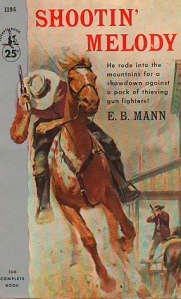
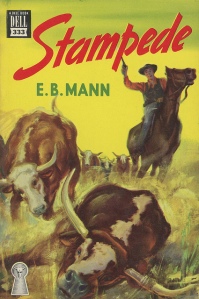

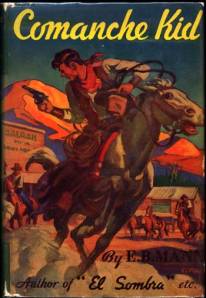


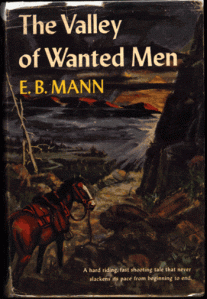
Eric – We’re glad that you discovered Mann and get to appreciate a past master. Always nice to hear that our efforts to keep his memory alive does indeed bear fruit from time to time. Here’s to a lot of happy future reading!
I was waiting on an appointment in Owego, New York and happened to glance into an alcove where The River Row Book Store leaves books for free. I found two westerns, by the same author, no less. Some one named EB Mann. Well, the first one I read was Thirsty Range and I just started Stampede, fantastic. How wonderful to be able to Google someone and discover a wealth of information! Not to mention more titles to look for. The cover art above is fantastic, my volumes were published in the 40’s and are not in good shape, but I will be on the look out for more.